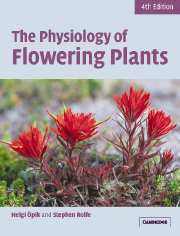Book contents
- Frontmatter
- Contents
- Preface
- Chapter 1 Introduction
- Part I Nutrition and transport
- Part II Growth and development
- Chapter 6 Growth as a quantitative process
- Chapter 7 Plant growth hormones
- Chapter 8 Cell growth and differentiation
- Chapter 9 Vegetative development
- Chapter 10 Photomorphogenesis
- Chapter 11 Reproductive development
- Chapter 12 Growth movements
- Chapter 13 Resistance to stress
- Appendix
- Index
- References
Chapter 10 - Photomorphogenesis
Published online by Cambridge University Press: 05 June 2012
- Frontmatter
- Contents
- Preface
- Chapter 1 Introduction
- Part I Nutrition and transport
- Part II Growth and development
- Chapter 6 Growth as a quantitative process
- Chapter 7 Plant growth hormones
- Chapter 8 Cell growth and differentiation
- Chapter 9 Vegetative development
- Chapter 10 Photomorphogenesis
- Chapter 11 Reproductive development
- Chapter 12 Growth movements
- Chapter 13 Resistance to stress
- Appendix
- Index
- References
Summary
Introduction
Light is critically important to plants. The majority of them are photosynthetic and light provides the energy source required for growth. However, light is equally important for the normal development of plants as an information medium. In the environment light is a very complex and dynamic signal. It varies in quantity, quality (colour) and direction over timescales ranging from seconds to months (Fig. 10.1). These different variables can indicate the passing of the seasons, the availability of new habitats for growth or the presence of neighbouring vegetation which may compete for resources. Therefore it is not surprising that many aspects of plant growth and development are strongly influenced by light. The plant, too, is a complicated and ever-changing system, and the response of a plant to a given set of environmental conditions will depend upon its developmental state. As discussed in Chapter 9, plants pass through a juvenile state where their response to environmental signals differs from that of mature plants. Likewise, signals which stimulate a mature plant to flower may cause the seed of the same species to germinate – radically different developmental pathways. Similarly, plant responses are species-specific. Whilst a fast-growing weed such as Chenopodium album will respond to shaded conditions (i.e. low light) by elongating rapidly, rainforest tree seedlings can persist under a vegetation canopy for many years and commence rapid growth only when a gap opens in the forest canopy.
- Type
- Chapter
- Information
- The Physiology of Flowering Plants , pp. 246 - 269Publisher: Cambridge University PressPrint publication year: 2005



